

Machine learning. Machine learning is a subfield of computer science[1] that evolved from the study of pattern recognition and computational learning theory in artificial intelligence.[1] Machine learning explores the construction and study of algorithms that can learn from and make predictions on data.[2] Such algorithms operate by building a model from example inputs in order to make data-driven predictions or decisions,[3]:2 rather than following strictly static program instructions.
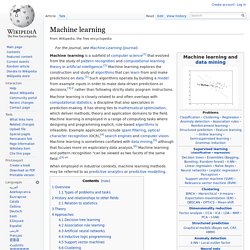
Machine learning is closely related to and often overlaps with computational statistics; a discipline that also specializes in prediction-making. It has strong ties to mathematical optimization, which deliver methods, theory and application domains to the field. Unsupervised learning. In machine learning, the problem of unsupervised learning is that of trying to find hidden structure in unlabeled data.

Since the examples given to the learner are unlabeled, there is no error or reward signal to evaluate a potential solution. This distinguishes unsupervised learning from supervised learning and reinforcement learning. Unsupervised learning is closely related to the problem of density estimation in statistics.[1] However unsupervised learning also encompasses many other techniques that seek to summarize and explain key features of the data. Many methods employed in unsupervised learning are based on data mining methods used to preprocess[citation needed] data. K-means clustering. K-means clustering is a method of vector quantization, originally from signal processing, that is popular for cluster analysis in data mining. k-means clustering aims to partition n observations into k clusters in which each observation belongs to the cluster with the nearest mean, serving as a prototype of the cluster.

This results in a partitioning of the data space into Voronoi cells. The problem is computationally difficult (NP-hard); however, there are efficient heuristic algorithms that are commonly employed and converge quickly to a local optimum. These are usually similar to the expectation-maximization algorithm for mixtures of Gaussian distributions via an iterative refinement approach employed by both algorithms. Additionally, they both use cluster centers to model the data; however, k-means clustering tends to find clusters of comparable spatial extent, while the expectation-maximization mechanism allows clusters to have different shapes. Canopy clustering algorithm. The canopy clustering algorithm is an unsupervised pre-clustering algorithm, often used as preprocessing step for the K-means algorithm or the Hierarchical clustering algorithm.
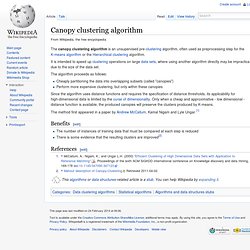
It is intended to speed up clustering operations on large data sets, where using another algorithm directly may be impractical due to the size of the data set. The algorithm proceeds as follows: Cheaply partitioning the data into overlapping subsets (called "canopies")Perform more expensive clustering, but only within these canopies Since the algorithm uses distance functions and requires the specification of distance thresholds, its applicability for high-dimensional data is limited by the curse of dimensionality. Only when a cheap and approximative - low dimensional - distance function is available, the produced canopies will preserve the clusters produced by K-means.
The method first appeared in a paper by Andrew McCallum, Kamal Nigam and Lyle Ungar.[1] Principal component analysis. PCA of a multivariate Gaussian distribution centered at (1,3) with a standard deviation of 3 in roughly the (0.878, 0.478) direction and of 1 in the orthogonal direction.

The vectors shown are the eigenvectors of the covariance matrix scaled by the square root of the corresponding eigenvalue, and shifted so their tails are at the mean. Principal component analysis (PCA) is a statistical procedure that uses orthogonal transformation to convert a set of observations of possibly correlated variables into a set of values of linearly uncorrelated variables called principal components. The number of principal components is less than or equal to the number of original variables. PCA is closely related to factor analysis. Factor analysis typically incorporates more domain specific assumptions about the underlying structure and solves eigenvectors of a slightly different matrix.
Supervised learning. Supervised learning is the machine learning task of inferring a function from labeled training data.[1] The training data consist of a set of training examples.
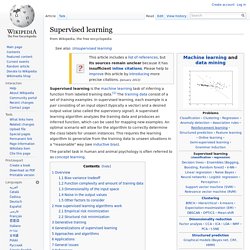
In supervised learning, each example is a pair consisting of an input object (typically a vector) and a desired output value (also called the supervisory signal). A supervised learning algorithm analyzes the training data and produces an inferred function, which can be used for mapping new examples. An optimal scenario will allow for the algorithm to correctly determine the class labels for unseen instances. This requires the learning algorithm to generalize from the training data to unseen situations in a "reasonable" way (see inductive bias). The parallel task in human and animal psychology is often referred to as concept learning. Overview[edit] Generative model. In probability and statistics, a generative model is a model for randomly generating observable data, typically given some hidden parameters.

It specifies a joint probability distribution over observation and label sequences. Generative models are used in machine learning for either modeling data directly (i.e., modeling observations drawn from a probability density function), or as an intermediate step to forming a conditional probability density function.
Hidden Markov model. In simpler Markov models (like a Markov chain), the state is directly visible to the observer, and therefore the state transition probabilities are the only parameters.
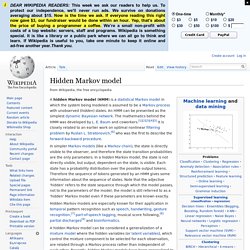
In a hidden Markov model, the state is not directly visible, but output, dependent on the state, is visible. Each state has a probability distribution over the possible output tokens. Naive Bayes classifier. A naive Bayes classifier is a simple probabilistic classifier based on applying Bayes' theorem with strong (naive) independence assumptions.
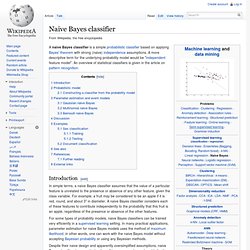
A more descriptive term for the underlying probability model would be "independent feature model". An overview of statistical classifiers is given in the article on pattern recognition. Introduction[edit] In simple terms, a naive Bayes classifier assumes that the value of a particular feature is unrelated to the presence or absence of any other feature, given the class variable.
For example, a fruit may be considered to be an apple if it is red, round, and about 3" in diameter. For some types of probability models, naive Bayes classifiers can be trained very efficiently in a supervised learning setting. Despite their naive design and apparently oversimplified assumptions, naive Bayes classifiers have worked quite well in many complex real-world situations.
Latent Dirichlet allocation. Discriminative model. Discriminative models, also called conditional models, are a class of models used in machine learning for modeling the dependence of an unobserved variable on an observed variable .
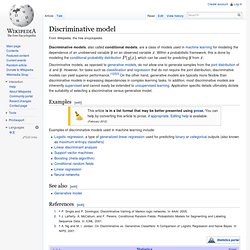
Within a probabilistic framework, this is done by modeling the conditional probability distribution , which can be used for predicting from Discriminative models, as opposed to generative models, do not allow one to generate samples from the joint distribution of and. Conditional random field. Conditional random fields (CRFs) are a class of statistical modelling method often applied in pattern recognition and machine learning, where they are used for structured prediction. Whereas an ordinary classifier predicts a label for a single sample without regard to "neighboring" samples, a CRF can take context into account; e.g., the linear chain CRF popular in natural language processing predicts sequences of labels for sequences of input samples.
Linear discriminant analysis. LDA is closely related to analysis of variance (ANOVA) and regression analysis, which also attempt to express one dependent variable as a linear combination of other features or measurements.[1][2] However, ANOVA uses categorical independent variables and a continuous dependent variable, whereas discriminant analysis has continuous independent variables and a categorical dependent variable (i.e. the class label).[3] Logistic regression and probit regression are more similar to LDA than ANOVA is, as they also explain a categorical variable by the values of continuous independent variables.
These other methods are preferable in applications where it is not reasonable to assume that the independent variables are normally distributed, which is a fundamental assumption of the LDA method. LDA works when the measurements made on independent variables for each observation are continuous quantities. LDA for two classes[edit] Support vector machine. In machine learning, support vector machines (SVMs, also support vector networks[1]) are supervised learning models with associated learning algorithms that analyze data and recognize patterns, used for classification and regression analysis. Given a set of training examples, each marked as belonging to one of two categories, an SVM training algorithm builds a model that assigns new examples into one category or the other, making it a non-probabilistic binary linear classifier.
An SVM model is a representation of the examples as points in space, mapped so that the examples of the separate categories are divided by a clear gap that is as wide as possible. New examples are then mapped into that same space and predicted to belong to a category based on which side of the gap they fall on. Definition[edit] Whereas the original problem may be stated in a finite dimensional space, it often happens that the sets to discriminate are not linearly separable in that space.
Note that if. Artificial neural network. An artificial neural network is an interconnected group of nodes, akin to the vast network of neurons in a brain. Here, each circular node represents an artificial neuron and an arrow represents a connection from the output of one neuron to the input of another. For example, a neural network for handwriting recognition is defined by a set of input neurons which may be activated by the pixels of an input image.
After being weighted and transformed by a function (determined by the network's designer), the activations of these neurons are then passed on to other neurons. This process is repeated until finally, an output neuron is activated. This determines which character was read. Like other machine learning methods - systems that learn from data - neural networks have been used to solve a wide variety of tasks that are hard to solve using ordinary rule-based programming, including computer vision and speech recognition.
Background[edit] Principle of maximum entropy. Barack Obama. Barack Hussein Obama II ( i/bəˈrɑːk huːˈseɪn oʊˈbɑːmə/; born August 4, 1961) is the 44th and current President of the United States, and the first African American to hold the office. Born in Honolulu, Hawaii, Obama is a graduate of Columbia University and Harvard Law School, where he served as president of the Harvard Law Review. He was a community organizer in Chicago before earning his law degree. He worked as a civil rights attorney and taught constitutional law at the University of Chicago Law School from 1992 to 2004. He served three terms representing the 13th District in the Illinois Senate from 1997 to 2004, running unsuccessfully for the United States House of Representatives in 2000.
Obama was re-elected president in November 2012, defeating Republican nominee Mitt Romney, and was sworn in for a second term on January 20, 2013. Early life and career Community organizer and Harvard Law School In late 1988, Obama entered Harvard Law School. Legislative career: 1997–2008. Albert Einstein. Albert Einstein (/ˈælbərt ˈaɪnʃtaɪn/; German: [ˈalbɐrt ˈaɪnʃtaɪn]; 14 March 1879 – 18 April 1955) was a German-born theoretical physicist.